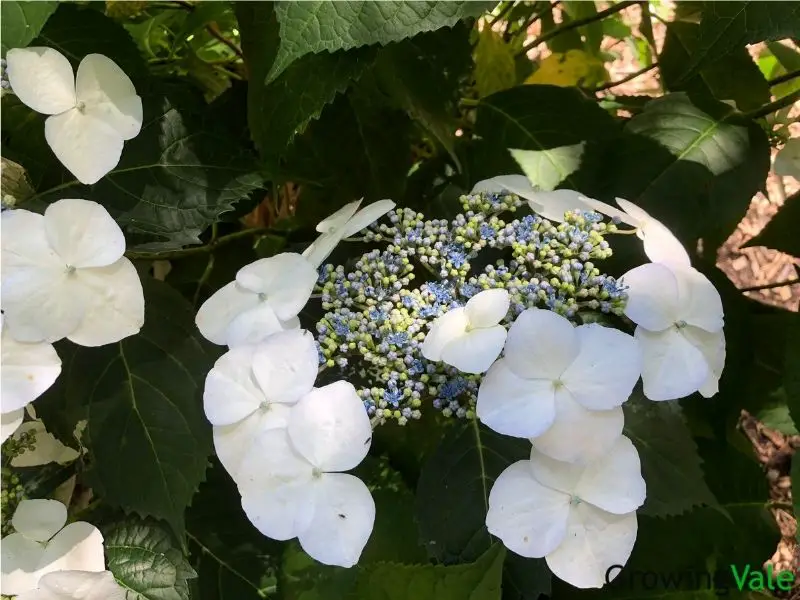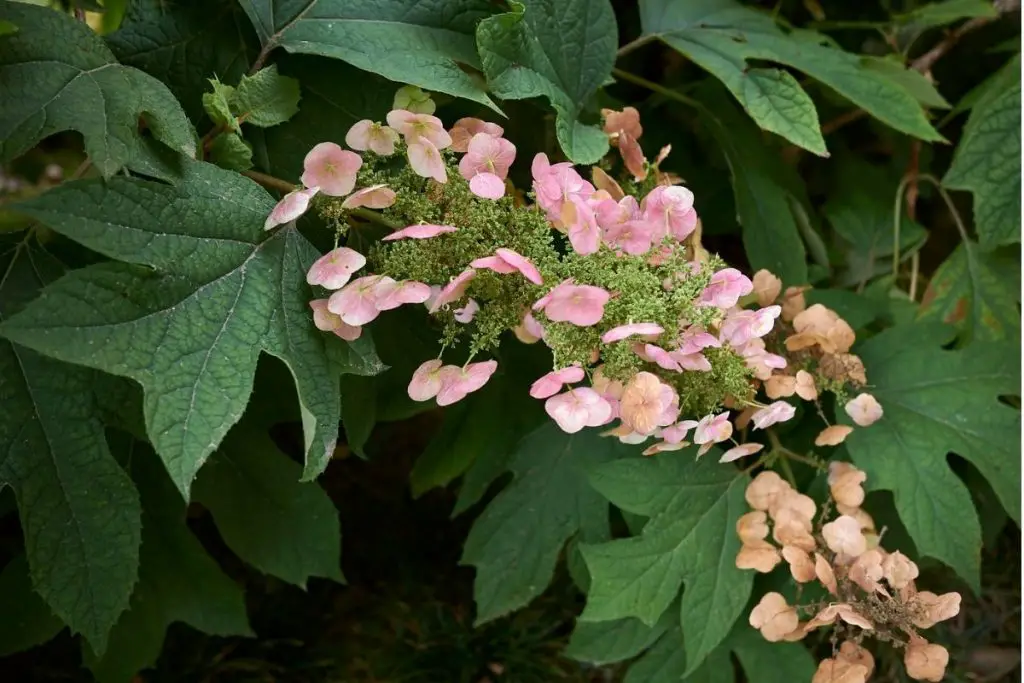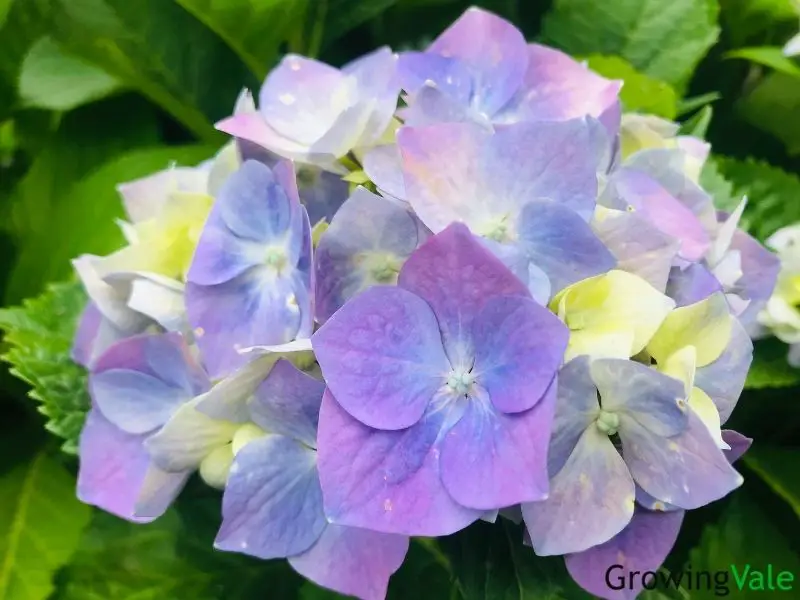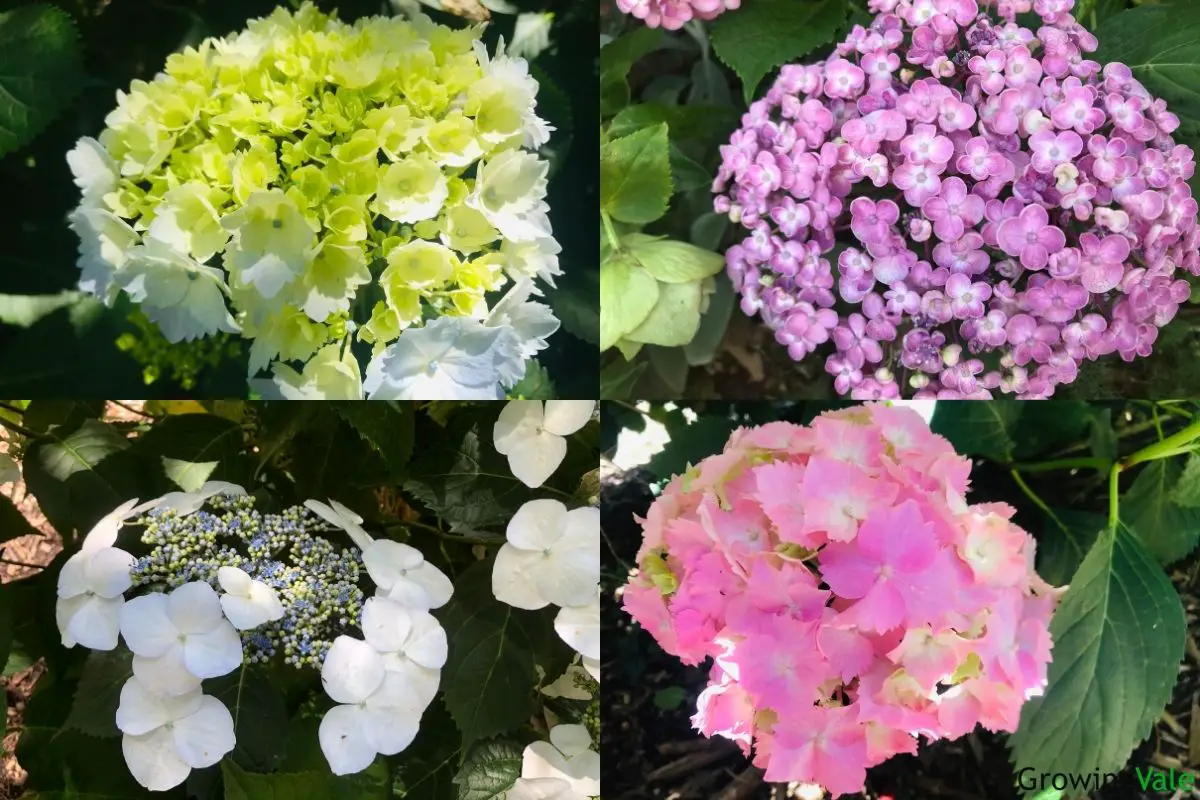Hydrangeas are easy to grow, require little maintenance, and are adaptable to soil conditions.
The main downside is that many hydrangeas require a large space in which to spread, so if space is limited, it is well worth checking out the variety carefully before choosing your plant as smaller types are available.
Some sources will tell you there are 5 species of hydrangea, others 20, and some even 75 – but it doesn’t matter because there are just a handful of varieties that you will commonly see in gardens.
Each of the five hydrangea species listed is a member of the Hydrangeaceae family.

You can break the plants down into:
- the large-leaved, blousy blooms of the Hydrangea macrophylla,
- the dainty lacecap, known as Hydrangea macrophylla normalis,
- the hardy mountain type, the Hydrangea macrophylla ssp. serrata,
- the large cone-shaped blooms of the Hydrangea paniculata,
- the wild-growing, and large white pom-pom flowered variety, of the Hydrangea arborescens
- the Hydrangea quercifolia, or oak-leaved hydrangea, which gets its name because of the distinctive shape of its leaves,
- the climbing, large-bloomed Hydrangea petiolaris.
#1. Hydrangea macrophylla
H. macrophylla is also known as the French hydrangeas, bigleaf hydrangeas or hortensia. It includes several subspecies.
It is more than likely that the hydrangeas you see in bloom either in a garden or the florist’s shop are one of the H. macrophylla types.
This group includes the large, oval-shaped leaves, large-flowered variety also known as mopheads due to their rounded shape.
Also in this group are the equally showy but flatter flower heads of the lacecap hydrangeas.

H. macrophylla are the easiest hydrangeas to grow, requiring the least and simplest maintenance. Normally just a simple tidying up and removal of deadwood in the spring is sufficient. The newer cultivars will flower on both new and old wood; however, older plants will only bloom on old wood which means that pruning needs to be carried out once the plants have finished flowering.
The flowers make excellent and long-lasting cut flowers hence their popularity with florists. The colors available are red, pink, purple, blue, and white.
H. macrophylla is native to Japan and whilst most will grow to about 6 feet tall and about 6 ½ feet wide, there are smaller varieties available which can be grown as dwarf hydrangeas. It is a deciduous plant that produces large, showy blooms in shades of pink or blue during the summer months.
This variety of hydrangea can also change its flower color depending upon the soil acidity. If the soil is rather acidic, then the flowers produced will be blue, and if the soil is alkaline then the flowers will be pink.
Ideally, this plant will grow in a partly shaded position but it is possible to grow it in a more sunny position, providing the soil is kept consistently moist.
Another smaller, winter hardy and more compact type that is native to cooler mountainous regions of northern Japan is called Hydrangea serrata or mountain hydrangeas. These plants will produce long-lasting showy blooms.
#2. Hydrangea paniculata
Also known as panicle hydrangeas, H. paniculata is instantly recognizable by its cone-shaped flowers. Its flowers are quite different from those of the H. macrophylla. It is a deciduous shrub and if not pruned regularly, some varieties will reach heights of 2.5 m. Fortunately, if you have a small garden, smaller varieties of H. paniculata are also available.
You can use this plant to create a “tree hydrangea” if you prune it to have a single trunk by removing competing leader shoots. Its white or cream-colored flowers are large and long-lasting.
This type is less common than the H. macrophylla; perhaps due to the more intensive pruning required to keep them at their best.
Some popular selections of this variety include Hydrangea Paniculata ‘Limelight’, ‘Grandiflora’, ‘Tardiva’, ‘Pink Diamond’ and ‘Vanilla Strawberry’.
#3. Hydrangea arborescens
This shrubby hydrangea produces large flowers, which turn from green-white to pure white with maturity. The flowers are approximately 20 cm in size.
Commonly known as smooth hydrangeas or wild hydrangeas, this bush is native to riverbanks, rocky wooded slopes, and tolerant of poor soil conditions. It will grow in both cold climates and also in warmer areas.
H. arborescens needs well-drained soil if grown in a shady place. This shrub can also grow in sunnier positions, providing it is planted in soil that remains consistently moist.
Growing these bushes will reward you with enormous blooms during the summer which can last for two months. Like almost all varieties of hydrangea, H.arborescens is a deciduous plant.
The white flowers contrast beautifully against the dark green, heart-shaped leaves. Unlike the H. macrophylla varieties, it is not possible to change the flower color by changing the soil acidity. The flowers of this variety will always be white.
#4. Hydrangea quercifolia

H. quercifolia is commonly known as the oakleaf hydrangea. This plant is native to the United States, rather than Asia, and grows naturally in woodland settings in the southeast of the USA.
Like the H. Macrophylla, the oak leaf hydrangea blooms on old wood so once it has finished flowering, it should be pruned so that the following years’ blooms will be preserved. Care for the oak leaf hydrangea is easy, and you will find that this plant is not adversely affected by pests or disease.
This plant is considerably smaller than many other hydrangeas; it grows as a mound-forming shrub and is deciduous. Its flowers start white and gradually mature to a shade of pinkish purple. If left on the plant after the new blooms stop, they will remain attractive for a long time.
This plant provides additional elements of interest, with the lobed shape and autumn color of the leaves and the peeling branches in winter.
This is a tough plant and cold-hardy plant that is also drought tolerant.
#5. Hydrangea petiolaris
Commonly referred to as climbing hydrangea (Hydrangea anomala ssp. petiolaris), this is a real treasure of a plant. To begin with, it can be slow to get established, but once successful it will reward you with vigorous growth and an abundance of long-lasting white, summer flowers.
You don’t even have to provide this plant with any support. It will climb and hook itself onto even the smoothest of wall surfaces without any help.
If you wish to grow a climber up a wall in a shady or north-facing location, this is possibly your best choice of plant. A perfect choice too if you have an ugly garden shed you wish to hide!
H. Petiolaris is equally attractive if grown over an arch, a porch, or even up a dead or decayed tree trunk. This is an excellent choice if you are looking for a low-maintenance flowering climber that will come back year after year.
It is even possible to grow H. Petiolaris for ground cover. If there is no support for the plant to use to climb, it will cover a large area if grown along the ground. If you have inherited an established climbing hydrangea, you are lucky!
Which Type of Hydrangea Is Best for You?

In summary, you should choose your hydrangea with care before purchase and before planting in the ground. Consider the space you have available and also the amount of sunshine that the plant will receive. These are perhaps the two most important factors to consider when selecting an appropriate hydrangea for your garden.
You will find that amongst the many hydrangeas available, there will be a plant for you and your growing conditions. Whether you are looking to plant in full sun, in shade, or for a plant with cold tolerance, or one that is easy to care for, or with long-lasting blooms, or with autumn interest, or for cut flowers, there will be a variety to suit. Perhaps the hydrangea does have it all!
See more:
~ image source: depositphotos/simonapavan

